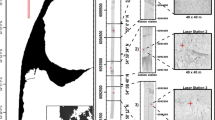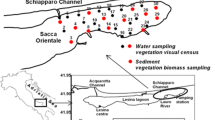Abstract
A basis to monitor erosion shear stress of tidal flat surfaces by means of optical remote sensing has been developed. Erosion shear stress and corresponding bio-geochemical parameters of different tidal flats were measured during five years in the Sylt/Rømø Bight in Germany. A significant dependence between the erosion shear stress and the benthic diatom chlorophylla concentration in the uppermost 1 mm layer was found for the muddy areas. This dependence decreases with decreasing grain-size fraction <63 µm. For stations with low phytobenthic coverage a weak dependence of erosion shear stress on grain-size fraction <63 µm was found.
Using optical techniques two main classes can be distinguished from ground based measured high resolution reflectance spectra. The first class contains information on the sediments type i.e. grain-size fraction <63 µm. The second class corresponds to the phytobenthos which can be subdivided into benthic diatoms and other phytobenthic species. A significant correlation was found between reflectance spectra and grain-size fraction <63 µm and also between reflectance spectra and the benthic diatom chlorophylla concentration. So the erodibility of tidal flats can be mapped with optical remote sensing when the benthic chlorophylla concentration and sediment grain-size fraction <63 µm are used for estimation of die erosion shear stress. Optical measurements and erosion shear stress measurements and their relationships are discussed.
Kurzfassung
In mehrjährigen Feldversuchen wurden Grundlagen für ein Monitoring kritischer Schubspannungen von Wattflächen mittels optischer Fernerkundung entwickelt. Die Messungen wurden in zwei Bereichen des Nordfrieschen Wattenmeeres, der Sylt-Rømø Bucht und der Meldorfer Bucht bei Büsum, durchgeführt. Für Schlickwatten zeigen die kritischen Schubspannungen eine deutliche Abhängigkeit von der Chloro-phylla Konzentration benthischer Diatomeen an der Oberfläche. Diese Abhängigkeit wird mit abnehmendem Feinkornanteil der Sedimente schwächer. An Stellen mit geringer Bedeckung durch Diatomeen zeigt sich eine schwache Abhängigkeit der kritischen Schubspannung vom Feinkornanteil <63 µm der obersten Sedimentschicht.
Reflexionsspektren von Wattoberflächen mit unterschiedlicher Bedeckung von Phytobenthos wurden mit hoher Wellenlängenauflösung aufgezeichnet. Zwei Klassen von Spektren lassen sich dabei unterscheiden. Die erste Klasse enthält als Information den Feinkornanteil <63 µm der Wattoberflächen für bewuchsfreie Bereiche. Die zweite Klasse ist dem Phytobenthos zugeordnet und kann anhand klarer Spektralsignaturen in Mikrophytobenthos und weitere Makrophyten unterteilt werden. Zwischen den Reflexionsspektren und dem Feinkornanteil sowie der Chlorophyll-a Konzentration des Mirkophytobenthos bestehen signifikante Korrelationen.
Eine Kartierung kritischer Schubspannungen aus optischer Fernerkundung über den Feinkornanteil und die Chlorophyll-a Konzentration des Mikrophytobenthos ist daher möglich. Die Messungen der kritischen Schubspannungen und Reflexionsspektren werden im einzelnen diskutiert sowie funktionale Zusammenhänge hergeleitet.
Similar content being viewed by others
References
Asmus, R. M. &Bauerfeind, E. (1994): The microphytobenthos of Königshafen — spatial and seasonal distribution on a sandy tidal flat. — Helgoländer Meeresunters.,48: 257–276.
Asmus, R. M. &Jensen, M. H. &Murphy, D. &Doerffer, R. (1997): Primäiproduktion von Mikrophytobenthos, Phytoplankton und jährlicher Biomasseertrag des Makrophytobenthos. — In:Gätje, C. &Reise, K. [Eds.]: Ökosystem Wattenmeer: Austausch-, Transport- und Stofmmwandlungsnrozesse: 367–391; Berlin (Springer).
Bayerl, K.-A. &Austen, I. &Köster, R. &Pejrup, M. &Witte, G. (1997): Dynamik der Sedimente im Lister Tidebecken. — In:Gätje, C. &Reise, K. [Eds.]: Ökosystem Wattenmeer: Austausch-, Transport- und Stoffumwandlungsprozesse: 127–159; Berlin (Springer).
Austen, I. (1994): The surficial sediments of Königshafen-variations over the past 50 years. — Helgoländer Meeresunters.,48: 163–171.
Coles, S. M. (1979): Benthic microalgal populations on intertidal sediments and their role as precursors to salt marsh development. — In:Jeffries, R. L. &Davy, A.J. [Eds.]: Ecological Processes in Coastal Environments: 25–42; Oxford (Blackwell).
Cornelisse, J. M. &Mulder, H. P.J. &Williamson, H. &Witte, G. &Houwing, E. J. (1994): On the development of instruments for in situ erosion measurements. — 4th Nearshore and Estuarine Cohesive Sediment Transport Conference, Wallingford.
de Jonge, V. N. &van Beusekom, J. E. E. (1995): Wind and tide induced resuspension of sediment and microphytobenthos from tidal flats in the Ems estuary. — Limnol. and Oceanogr.,40: 766–778.
de Jonge, V. N. &van den Berg, J. (1987): Experiments on the Resuspension of Estuarine Sediments Containing Benthic Diatoms. — Estuarine, Coastal and Shelf Sci.,24: 725–740.
DIN 4188, Teil 1: Siebböden; Drahtsiebböden für Analysensiebe. — Deutsche Normen, Okt. 1977.
DIN 18128: Baugrund, Versuche und Versuchsgeräte; Bestimmung des Glühverlusts. — Deutsche Normen, Nov. 1990.
Figge, K. &Köster, R. &Thiel, H. R. &Wieland, P. (1980): Schlickuntersuchungen im Wattenmeer der deutschen Bucht (Zwischenbericht über ein Forschungsprojekt des KFKI). — Küste,35: 187–204.
Flemming, B. W. &Nyandwi, N. (1994): Land Reclamation as a Cause of Fine-Grained Sediment Depletion in Backbarrier Tidal Flats (Southern North Sea). — Netherl. J. aquat. Ecol.,28 (3–4): 229–307.
Führböter, A. (1983): Über Mirkobiologische Einflüsse auf den Erosionsbeginn bei Sandwatten. — Wasser und Boden,3: 106–116.
Gast, R. &Köster, R. &Runte, K. H. (1984): Die Wattsedimente der Nördlichen und Mittleren Meldorfer Bucht. Untersuchung zur Frage der Sedimentverteilung und der Schlicksedimentation. — Küste,40: 165–257.
Grant, J. &Bathman, U. V. &Mills, E. L. (1986): The interaction between benthic diatom films and sediment transport. — Estuarine, Coastal and Shelf Sci.,23: 225–238.
Higelke, B. (1997): Morphodynamik des Lister Tidebeckens. — In:Gätje, Ch. &Reise, K. [Eds.]: Ökosystem Wattenmeer. Austausch-, Transport- und Stoffumwandlungsprozesse: 103–126; Berlin (Springer).
Holland, A. F. &Zingmark, R. G. &Dean, J. M. (1974): Quantitative evidence concerning the stabilization of sediments by marine benthic diatoms. — Mar. Biol.,27: 191–196.
Liu, D. &Wong, P. T. S. &Dutka, B. J. (1972): Determination of carbohydrate in lake sediment by a modified phenol-sulfuric acid method. — Water Res.,7: 741–746.
Kleeberg, U. (1990): Kartierung der Sedimentverteilung im Wattenmeer durch integrierte Asuwertung von Satellitendaten und Daten aus der Wattenmeerdatenbank der GKSS. — Diplom Thesis, Universität Trier.
Paterson, D. M. (1994): Biological mediation of sediment erodibility: Ecology and physical dynamics. — Proc. Intercoh 1994; Oxford.
Paterson, D. M. &Yallop, M. L. &George, C. (1994): Spatial Variability in the Sediment Erodibility on the Island of Texel. — InKrummbein, W et al. [Eds.]: Biostabilization of Sediments: 107–120; Oldenburg.
Reise, K. &Lackschwitz, D. (1997): Benthos des Wattenmeeres zwischen Sylt und Rømø. — In:Gättje, Ch. &.Reise, K. [Eds.]: Ökosystem Wattenmeer. Austausch-, Transport- und Stoffumwandlungsprozesse: 55–64; Berlin (Springer).
Reise, K. et al. (1996): SWAP Sylter Wattenmeer Austauschprozesse Projektsynthese. — 447; Tönning.
Reise, K. et al. (1997): Austauschprozesse im Sylt-Rømø Wattenmeer — Zusammenschau und Ausblick. — In:Gättje, Ch. &Reise, K. [Eds.]: Ökosystem Wattenmeer. Austausch-, Transport- und Stoffumwandlungsprozesse: 529–558; Berlin (Springer).
Schünemann, M. &Kühl, H. (1993): Experimental investigations of the erosional behaviour of naturally formed mud from the Elbe-estuary and the adjacent Wadden Sea. — In:Metha, A.J. [Ed.]: Coastal and Estuarine Stud.,42: 314–330.
Williamson, H. J. &Ockenden, M. C. (1996): ISIS: An instrument for measuring erosion shear stressin situ. — Estuarine, Coastal and Shelf Sci.,42: 1–18.
Witte, G. &Kühl, H. (1996): Facilities for sedimentation and erosion measurements. — Arch. Hydrobiol. Spec. Iss. Advanc. Limnol.,47: 121–125
Wright, S. W. &Mantoura, R. F. C. &Jeffrey, S. W. &Llewellyn, C. A. &Bjørnland, T. &Repeta, D. &Welschmeyer, N. (1991): Improved HPLC method for the analysis of chlorophylls and Carotinoids from marine phytoplankton. — Mar. Ecol. Progr. Ser.,77: 183–196.
Yalin, M. S. (1977): Mechanics of sediment transport. — Oxford (Pergamon Press).
Yallop, M. &de Winder, B. &Paterson, D. M. &Stal, L. J. (1994): Comparative Structure, Primary Production and Biogenic Stabilization of Cohesive and Non-cohesive Marine Sediments Inhabited by Microphytobenthos. — Estuarine, Coastal and Shelf Sci.,39: 565–582.
Yates, M. G. &Jones, A. R. &McGrorty, S. &Goss-Custard, J. D. (1993): The Use of Satellite Imagery to Determine the Distribution of Intertidal Surface Sediments of The Wash, England. — Estuarine, Coastal and Shelf Sci.,36: 333–344.
Author information
Authors and Affiliations
Rights and permissions
About this article
Cite this article
Hakvoort, J.H.M., Heineke, M., Heymann, K. et al. Optical remote sensing of microphytobenthic biomass: a method to monitor tidal flat erodibility. Senckenbergiana maritima 29, 77–85 (1998). https://doi.org/10.1007/BF03043945
Received:
Revised:
Accepted:
Issue Date:
DOI: https://doi.org/10.1007/BF03043945




